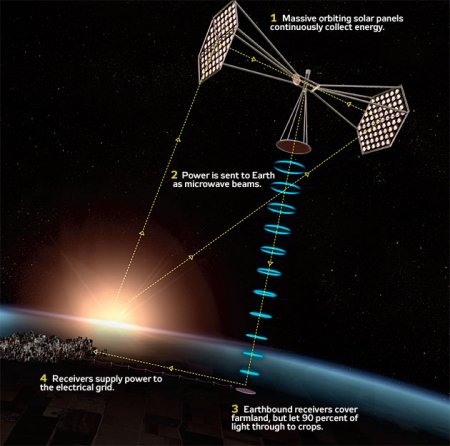Today, we are faced with many challenges such as global warming and the depletion of fossil fuels. These are important factors because if we use up all the resources, there will be nothing left for future generations. Based on this, I had a chance to look into three technologies that can tackle future energy shortages through this Blog.
First is space-based solar power. As we learned in ETP class, solar power is gaining popularity as a clean energy source, but there are many obstacles to overcome in establishing it as a main energy source which could replace fossil fuel. To satisfy the world’s energy needs, solar panels ten times as big as the Korean peninsula are needed even if the technology to transmit electricity and the efficiency of solar cells improve. Also, large amounts of energy are wasted due to differences between night and day, the weather, and the filtering effect of Earth’s atmospheric gases. [1]
What if we put solar panels in space? Space-based solar power is a technology that collects solar power from space. A satellite equipped with a solar panel is put into orbit 36,000 kilometers from the Earth. The satellite, which revolves around the Sun at the same speed as the Earth, converts solar energy into electricity, and transmits it back. As there are no electric wires linking the Earth and space, electricity is converted into microwaves or lasers before transmission. Antennas then receive the signal, and convert the microwaves or lasers back into electricity. As the technology uses solar energy which is then converted into electricity, the supply is limitless and there is no concern of pollution. [2]
Of course, there are obstacles that stand in the way of commercializing space-based solar power. The biggest challenge lies in the cost of sending generation facilities into space. In fact, the idea of space-based solar power was rejected in the past due to its astronomical cost. With the limited technology of the ’70s, the cost of making a generation facility was as much as US$ 300 billion to 1 trillion. However, with technological advancements, the cost has reduced dramatically. Moreover, the US company Spectrolab has succeeded in making a solar panel which improves the efficiency of converting solar energy into electricity from 19.9% to 40.7%. [3]
Second is advanced car batteries, the core technology of electric vehicles. Lithium-ion batteries of plug-in hybrid and electric vehicles have limitations such as the high cost and short driving distance.
Scientists are working hard to make batteries that are cheaper and more durable. And recently, lithium-air batteries have been attracting attention. These batteries are charged with oxygen from the air. In 2009, Japan’s National Institute of Advanced Industrial Science and Technology succeeded in developing a lithium-air battery with a capacity 300 times higher than the current lithium-ion batteries. [4] IBM set out to develop a highly efficient cell which will allow a car to go up to 800 kilometers on one charge. IBM believes lithium-air batteries will be 10 times more efficient than lithium-ion batteries which are currently widely used in cell phones and laptops. [5] It is expected that the commercialization of lithium-air batteries will change the landscape of the rechargeable battery market.
Third is utility storage. This technology compresses wind in underground storages, and stores solar energy in batteries. The US and Japan are making the utmost efforts to develop new materials to improve this technology. If combined with smart grid technology, utility storage will make it possible for us to consume energy in an environmentally-friendly and highly-efficient way.
The three technologies are necessary to make our Earth more sustainable and promising for the future. Therefore companies and governments should make investments to prepare for the post-fossil fuel era.
[1]. http://www.csa.com/discoveryguides/solar/review.pdf
[2]. http://www.pickar.caltech.edu/e103/Final%20Exams/Space%20Based%20Solar%20Power.pdf
[3]. http://www.solaripedia.com/files/163.pdf
[4]. http://www.greencarcongress.com/2009/07/aist-lithium-20090727.html
[5]. http://www.futureage.eu/download/prezentace_Bethune_web.pdf
[Fig]. http://martianchronicles.wordpress.com/2010/06/20/our-burning-need-for-energ/
[Video]. http://www.youtube.com/watch?feature=player_embedded&v=8pMFLpiqPAc


You must be logged in to post a comment.